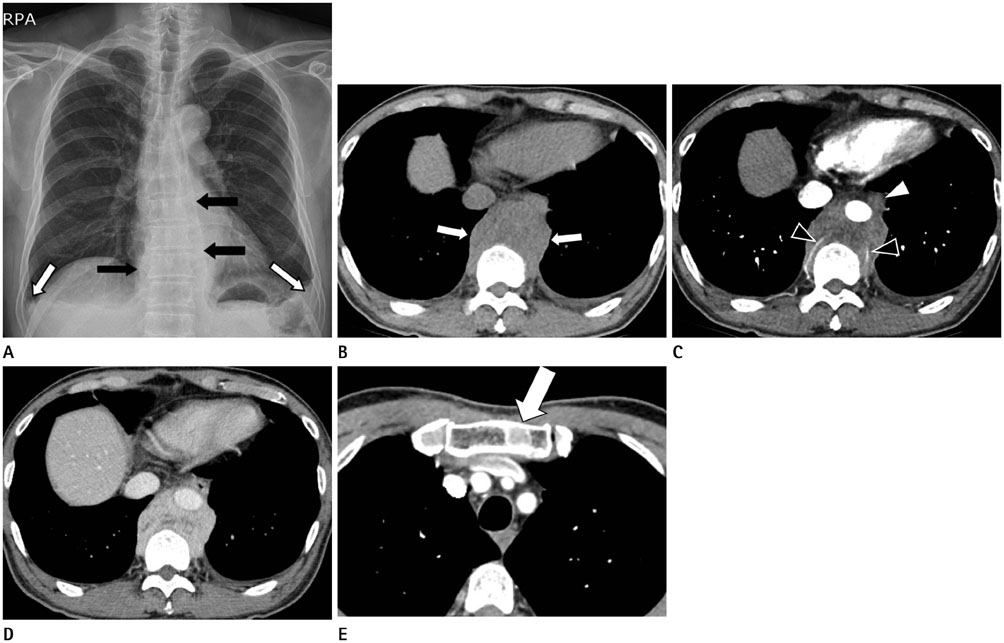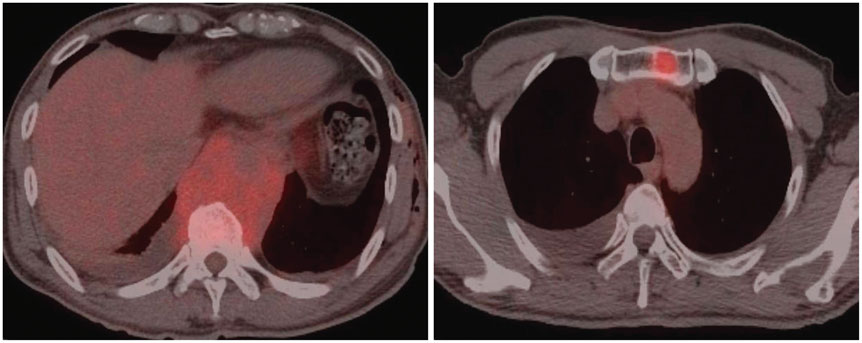J Korean Soc Radiol.
2016 Mar;74(3):199-203. 10.3348/jksr.2016.74.3.199.
Multiple Solitary Plasmacytomas Arising in the Posterior Mediastinum and Sternum: A Case Report
- Affiliations
-
- 1Department of Radiology, Sanggye Paik Hospital, Inje University College of Medicine, Seoul, Korea. s2621@paik.ac.kr
- 2Department of Emergency Medicine, Sanggye Paik Hospital, Inje University College of Medicine, Seoul, Korea.
- KMID: 2155281
- DOI: http://doi.org/10.3348/jksr.2016.74.3.199
Abstract
- Multiple solitary plasmacytoma is very rare disease, which occurs in multiple sites of soft tissue, bone or both without multiple myeloma. Almost 80-90% of extramedullary plasmacytomas develop in the head and neck area. Involvement of the mediastinum is extremely rare. A few cases of mediastinal plasmacytoma have been reported, and to the best of our knowledge, there is only one previous report of multiple plasmacytomas involving the posterior mediastinum. Herein, we describe an unusual case of multiple solitary plasmacytomas in a 67-year-old male involving the posterior mediastinum and sternum without evidence of bone marrow involvement.
MeSH Terms
Figure
Reference
-
1. Ooi GC, Chim JC, Au WY, Khong PL. Radiologic manifestations of primary solitary extramedullary and multiple solitary plasmacytomas. AJR Am J Roentgenol. 2006; 186:821–827.2. Masood A, Hudhud KH, Hegazi A, Syed G. Mediastinal plasmacytoma with multiple myeloma presenting as a diagnostic dilemma. Cases J. 2008; 1:116.3. Lee SY, Kim JH, Shin JS, Shin C, In KH, Kang KH, et al. A case of extramedullary plasmacytoma arising from the posterior mediastinum. Korean J Intern Med. 2005; 20:173–176.4. Hussain A, Singh M, Singh K, Bagga H. Multiple extramedullary plasmacytoma with lytic bony lesions: a rare case report. Case Rep Med. 2013; 2013:291359.5. Ahnach M, Marouan S, Rachid M, Madani A, Quessar A, Benchekroun S, et al. Extramedullary plasmocytoma relapsing at differents sites: an unusual presentation. Pan Afr Med J. 2013; 14:34.6. International Myeloma. Criteria for the classification of monoclonal gammopathies, multiple myeloma and related disorders: a report of the International Myeloma Working Group. Br J Haematol. 2003; 121:749–757.7. Luh SP, Lai YS, Tsai CH, Tsao TC. Extramedullary plasmacytoma (EMP): report of a case manifested as a mediastinal mass and multiple pulmonary nodules and review of literature. World J Surg Oncol. 2007; 5:123.8. Alexiou C, Kau RJ, Dietzfelbinger H, Kremer M, Spiess JC, Schratzenstaller B, et al. Extramedullary plasmacytoma: tumor occurrence and therapeutic concepts. Cancer. 1999; 85:2305–2314.
- Full Text Links
- Actions
-
Cited
- CITED
-
- Close
- Share
- Similar articles
-
- A Case of Extramedullary Plasmacytomas of Posterior Mediastinum, and Gingiva associated with Fulminant Hepatic Failure, which Developed in the Course of Multiple Myeloma
- Solitary Plasmacytoma of the Sternum
- Multiple Solitary Plasmacytomas Presenting with Painful Erythematous Swelling of the Upper Eyelid
- A Case of Extramedullary Plasmacytoma Arising from the Posterior Mediastinum
- Cutaneous Bronchogenic Cyst Over the Sternum: A Case Report



